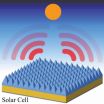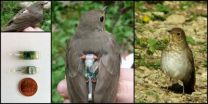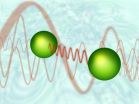(Press-News.org) WASHINGTON, July 22, 2014—Scientists may have overcome one of the major hurdles in developing high-efficiency, long-lasting solar cells—keeping them cool, even in the blistering heat of the noonday Sun.
By adding a specially patterned layer of silica glass to the surface of ordinary solar cells, a team of researchers led by Shanhui Fan, an electrical engineering professor at Stanford University in California has found a way to let solar cells cool themselves by shepherding away unwanted thermal radiation. The researchers describe their innovative design in the premiere issue of The Optical Society's (OSA) new open-access journal Optica.
Solar cells are among the most promising and widely used renewable energy technologies on the market today. Though readily available and easily manufactured, even the best designs convert only a fraction of the energy they receive from the Sun into usable electricity.
Part of this loss is the unavoidable consequence of converting sunlight into electricity. A surprisingly vexing amount, however, is due to solar cells overheating.
Under normal operating conditions, solar cells can easily reach temperatures of 130 degrees Fahrenheit (55 degrees Celsius) or more. These harsh conditions quickly sap efficiency and can markedly shorten the lifespan of a solar cell. Actively cooling solar cells, however—either by ventilation or coolants—would be prohibitively expensive and at odds with the need to optimize exposure to the Sun.
The newly proposed design avoids these problems by taking a more elegant, passive approach to cooling. By embedding tiny pyramid- and cone-shaped structures on an incredibly thin layer of silica glass, the researchers found a way of redirecting unwanted heat—in the form of infrared radiation—from the surface of solar cells, through the atmosphere, and back into space.
"Our new approach can lower the operating temperature of solar cells passively, improving energy conversion efficiency significantly and increasing the life expectancy of solar cells," said Linxiao Zhu, a physicist at Stanford and lead author on the Optica paper. "These two benefits should enable the continued success and adoption of solar cell technology."
Solar cells work by directly converting the Sun's rays into electrical energy. As photons of light pass into the semiconductor regions of the solar cells, they knock off electrons from the atoms, allowing electricity to flow freely, creating a current. The most successful and widely used designs, silicon semiconductors, however, convert less than 30 percent of the energy they receive from the Sun into electricity – even at peak efficiency.
The solar energy that is not converted generates waste heat, which inexorably lessens a solar cell's performance. For every one-degree Celsius (1.8 degree F) increase in temperature, the efficiency of a solar cell declines by about half a percent.
"That decline is very significant," said Aaswath Raman, a postdoctoral scholar at Stanford and co-author on the paper. "The solar cell industry invests significant amounts of capital to generate improvements in efficiency. Our method of carefully altering the layers that cover and enclose the solar cell can improve the efficiency of any underlying solar cell. This makes the design particularly relevant and important."
In addition, solar cells "age" more rapidly when their temperatures increase, with the rate of aging doubling for every increase of 18 degrees Fahrenheit.
To passively cool the solar cells, allowing them to give off excess heat without spending energy doing so, requires exploiting the basic properties of light as well as a special infrared "window" through Earth's atmosphere.
Different wavelengths of light interact with solar cells in very different ways—with visible light being the most efficient at generating electricity while infrared is more efficient at carrying heat. Different wavelengths also bend and refract differently, depending on the type and shape of the material they pass through.
The researchers harnessed these basic principles to allow visible light to pass through the added silica layer unimpeded while enhancing the amount of energy that is able to be carried away from the solar cells at thermal wavelengths.
"Silica is transparent to visible light, but it is also possible to fine-tune how it bends and refracts light of very specific wavelengths," said Fan, who is the corresponding author on the Optica paper. "A carefully designed layer of silica would not degrade the performance of the solar cell but it would enhance radiation at the predetermined thermal wavelengths to send the solar cell's heat away more effectively."
To test their idea, the researchers compared two different silica covering designs: one a flat surface approximately 5 millimeters thick and the other a thinner layer covered with pyramids and micro-cones just a few microns (one-thousandth of a millimeter) thick in any dimension. The size of these features was essential. By precisely controlling the width and height of the pyramids and micro-cones, they could be tuned to refract and redirect only the unwanted infrared wavelengths away from the solar cell and back out into space.
"The goal was to lower the operating temperature of the solar cell while maintaining its solar absorption," said Fan. "We were quite pleased to see that while the flat layer of silica provided some passive cooling, the patterned layer of silica considerably outperforms the 5 mm-thick uniform silica design, and has nearly identical performance as the ideal scheme."
Zhu and his colleagues are currently fabricating these devices and performing experimental tests on their design. Their next step is to demonstrate radiative cooling of solar cells in an outdoor environment. "We think that this work addresses an important technological problem in the operation and optimization of solar cells," he concluded, "and thus has substantial commercialization potential."
INFORMATION:
Paper: L. Zhu, A. Raman., K. Wang, M. Anoma, S. Fan, "Radiative Cooling of Solar Cells," Optica 1, 32-38 (2014).
EDITOR'S NOTE: The embargoed paper, images and interviews are available to members of the media upon request. Contact Jake Lynn at optica@ecius.net or 202.296.2002.
About Optica
Optica is an open-access, online-only journal dedicated to the rapid dissemination of high-impact peer-reviewed research across the entire spectrum of optics and photonics. Published monthly by The Optical Society's (OSA), Optica provides a forum for pioneering research to be swiftly accessed by the international community, whether that research is theoretical or experimental, fundamental or applied. Optica maintains a distinguished editorial board of more than 20 associate editors from around the world and is overseen by Editor-in-Chief Alex Gaeta of Cornell University. For more information, visit http://optica.osa.org.
About OSA
Founded in 1916, The Optical Society (OSA) is the leading professional society for scientists, engineers, students and business leaders who fuel discoveries, shape real-world applications and accelerate achievements in the science of light. Through world-renowned publications, meetings and membership programs, OSA provides quality research, inspired interactions and dedicated resources for its extensive global network of professionals in optics and photonics. For more information, visit http://www.osa.org.
Contact:
Jake Lynn
Environics Communications
202.296.2002
optica@ecius.net
Self-cooling solar cells boost power, last longer
2014-07-22
ELSE PRESS RELEASES FROM THIS DATE:
Major dopamine system helps restore consciousness after general anesthesia, study finds
2014-07-22
Chicago – July 22, 2014 – Researchers may be one step closer to better understanding how anesthesia works. A study in the August issue of Anesthesiology, the official medical journal of the American Society of Anesthesiologists® (ASA®), found stimulating a major dopamine-producing region in the brain, the ventral tegmental area (VTA), caused rats to wake from general anesthesia, suggesting that this region plays a key role in restoring consciousness after general anesthesia. Activating this region at the end of surgery could provide a novel approach to proactively induce ...
Creating optical cables out of thin air
2014-07-22
Imagine being able to instantaneously run an optical cable or fiber to any point on earth, or even into space. That's what Howard Milchberg, professor of physics and electrical and computer engineering at the University of Maryland, wants to do.
In a paper published today in the July 2014 issue of the journal Optica, Milchberg and his lab report using an "air waveguide" to enhance light signals collected from distant sources. These air waveguides could have many applications, including long-range laser communications, detecting pollution in the atmosphere, making high-resolution ...
Has Antarctic sea ice expansion been overestimated?
2014-07-22
New research suggests that Antarctic sea ice may not be expanding as fast as previously thought. A team of scientists say much of the increase measured for Southern Hemisphere sea ice could be due to a processing error in the satellite data. The findings are published today in The Cryosphere, a journal of the European Geosciences Union (EGU).
Arctic sea ice is retreating at a dramatic rate. In contrast, satellite observations suggest that sea ice cover in the Antarctic is expanding – albeit at a moderate rate – and that sea ice extent has reached record highs in recent ...
Mixed genes mix up the migrations of hybrid birds
2014-07-22
Mixed genes appear to drive hybrid birds to select more difficult routes than their parent species, according to new research from University of British Columbia zoologists.
"Instead of taking well-trodden paths through fertile areas, these birds choose to scale mountains and cross deserts," says UBC researcher Kira Delmore.
Delmore harnessed a flock of B.C. Swainson's thrushes with tiny geolocating backpacks to map their routes as they migrated south through the U.S. to Central and South America.
Many of the hybrid thrushes chose intermediary migration routes situated ...
New York squirrels are nuts about city life
2014-07-22
Curtin University-led research has shown squirrels have adapted to New York City's human behaviour, allowing them to thrive just as well, if not better, than their fellow squirrels in the woods.
Dr Bill Bateman, Senior Lecturer at Curtin's Department of Environment & Agriculture, led the study that proved eastern grey squirrels were able to modify their behaviour in urban environments and prevent unnecessary responses when humans acted in a predictable manner, such as staying on the footpath.
"As we rapidly increase the spread of urbanisation around the world, urban ...
LSUHSC contributes to work identifying new DNA regions associated with schizophrenia
2014-07-22
New Orleans, LA -- Nancy Buccola, MSN, APRN, PMHCNS-BC, CNE, Assistant Professor of Clinical Nursing at LSU Health Sciences Center New Orleans School of Nursing, contributed samples used in a study reporting new locations of genetic material associated with schizophrenia and also suggesting a possible link between the immune system and schizophrenia. The study, “Biological insights from 108 schizophrenia-associated genetic loci,” was published online July 22, 2014 in Nature, available at http://www.nature.com/nature/journal/vaop/ncurrent/full/nature13595.html.
...
Natural-terrain schoolyards reduce children's stress, says Colorado University-Boulder study
2014-07-22
Playing in schoolyards that feature natural habitats and trees and not just asphalt and recreation equipment reduces children's stress and inattention, according to a University of Colorado Boulder study.
Working on class assignments or gardening in such settings also provide stress-reducing benefits for youth, according to a paper published in the journal Health & Place. The study is one of the first of its kind to focus on the relationship between student access to green settings and stress.
"Many schools already offer stress management programs, but they're about ...
African-American homeownership increasingly less stable and more risky
2014-07-22
While historical barriers that excluded Black America from the homeowner market for decades have crumbled, there are signs that emerging types of racial inequality are making homeownership an increasingly risky investment for African-American home seekers. A new study from sociologists at Rice University and Cornell University found that African-Americans are 45 percent more likely than whites to switch from owning their homes to renting them.
The study, "Emerging Forms of Racial Inequality in Homeownership Exit, 1968-2009," examines racial inequality in transitions out ...
Low strength brain stimulation may be effective for depression
2014-07-22
Philadelphia, PA -- Brain stimulation treatments, like electroconvulsive therapy (ECT) and transcranial magnetic stimulation (TMS), are often effective for the treatment of depression. Like antidepressant medications, however, they typically have a delayed onset. For example, a patient may receive several weeks of regular ECT treatments before a full response is achieved.
Thus, there is an impetus to develop antidepressant treatments that act to rapidly improve mood.
Low field magnetic stimulation (LFMS) is one such potential new treatment with rapid mood-elevating ...
Boosting the force of empty space
2014-07-22
This news release is available in German.
Vacuum is not as empty as one might think. In fact, empty space is a bubbling soup of various virtual particles popping in and out of existence – a phenomenon called "vacuum fluctuations". Usually, such extremely short-lived particles remain completely unnoticed, but in certain cases vacuum forces can have a measurable effect. A team of researchers from the Weizmann Institute of Science (Rehovot, Israel) and the Vienna University of Technology has now proposed a method of amplifying these forces by several orders of magnitude ...







